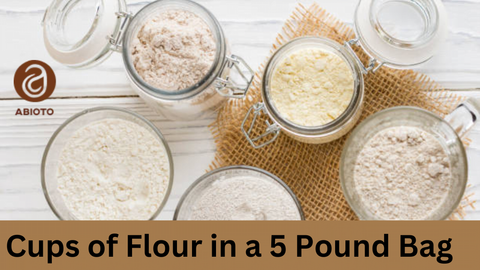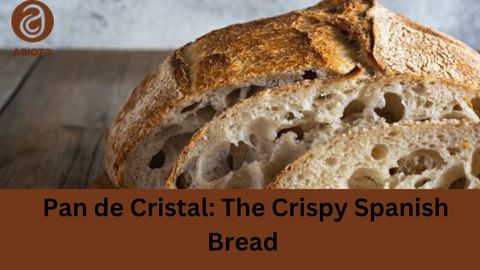When you're baking or cooking, it's essential to know the measurement conversions for various ingredients. One such ingredient is flour, and understanding how many cups are in a 5-pound bag can save you time and help to ensure the success of your recipes. In this article, we'll provide the conversion factor for a 5-pound bag of flour into cups.
It's essential to note that the number of cups in a 5-pound bag of flour can vary depending on the type of flour you're using and how densely packed it is. A standard rule of thumb is that a 5-pound bag of all-purpose flour contains about 17 to 20 cups. However, whole wheat flour and bread flour will likely contain fewer cups due to their denser texture.
Knowing the
best tools for baking conversion factor will make your baking and cooking experiences smoother and more accurate. Practice proper measuring techniques to ensure consistency and precision in your recipes. Armed with this information, you'll now be better equipped to tackle any recipe that calls for cups of flour.
Understanding Flour Measurements
Weight vs Volume
When measuring flour, it's essential to understand the difference between weight and volume measurements. Weight measurements, such as grams or pounds, provide a consistent measurement for flour. Volume measurements, like cups, may vary depending on how packed or settled the flour is in the cup. To ensure accurate and consistent results, it's recommended to use weight measurements for flour.
Flour Types and Weights
Different types of flour have different weights per cup. Here's a brief overview of various types of flour and their approximate weights per cup:
-
All-purpose flour: 120-130 grams per cup
-
Bread flour: 130-135 grams per cup
-
Cake flour: 100-110 grams per cup
-
Whole wheat flour: 120-130 grams per cup
-
Pastry flour: 110-120 grams per cup
-
Whole-wheat flour: 120-130 grams per cup
Keep in mind that these values can vary slightly depending on the brand and how the flour is stored.
Now, when it comes to a 5-pound bag of flour, you can calculate the approximate number of cups using the weight measurements given above. For example, assuming 1 cup of all-purpose flour weighs 125 grams, a 5-pound bag (2270 grams) would contain approximately 18 cups (dividing 2270 by 125). Remember to adapt the calculation to the specific type of flour you're using and the weight per cup mentioned above.
Converting Pounds to Cups
5 Pound Bag to Cups Conversion
When you want to convert a
5-pound bag of flour into cups, it's important to remember that the conversion depends on the density of the flour. There are
different types of flour, such as all-purpose flour, cake flour, and bread flour, which can cause variations in the measurement. A typical rule of thumb is to use 3.6-4.5 ounces per cup for most flours.
To convert a
5-pound bag of flour into cups, you will need to:
- Start by converting pounds to ounces:
- 5 pounds * 16 ounces per pound = 80 ounces
- Convert the ounces to cups using the flour's specific density:
- All-purpose flour: 80 ounces / 4.25 ounces per cup = approximately 18.8 cups
- Cake flour: 80 ounces / 4 ounces per cup = approximately 20 cups
- Bread flour: 80 ounces / 4.5 ounces per cup = approximately 17.8 cups
These conversions are approximate, as different flours have different densities.
Considering Flour Brands
It's important to consider the
brand of flour when converting a 5-pound bag into cups, as some brands may have slightly different densities. Most major brands provide their own conversion charts to help you obtain accurate measurements specific to their product.
For example:
-
Brand A might recommend 4 ounces per cup for their all-purpose flour, which would mean a 5-pound bag would yield 20 cups.
-
Brand B could suggest using 4.25 ounces per cup for their all-purpose flour, so a 5-pound bag would give you around 18.8 cups.
Always refer to the specific brand's recommendations when measuring flour for optimal results. That way, you can accurately assess the number of cups in your 5-pound bag of flour and achieve the best possible outcome in your cooking or baking endeavors.
Measuring Flour Accurately
When it comes to baking, measuring flour accurately is an essential skill. In this section, we will cover two methods to measure flour: using measuring cups and utilizing a kitchen scale.
Using Measuring Cups
Measuring cups are a common tool found in many kitchens. To measure flour accurately with measuring cups, follow these steps:
-
Choose the right cup: Select the appropriate measuring cup size for your recipe, whether it be a 1 cup, 1/2 cup, or another measurement. Make sure the cup is clean and dry.
-
Scoop and fill: Using a scoop or large spoon, fill the measuring cup with the flour. Do not pack the flour; instead, let it gently fill the cup. Overfilling the cup slightly is better than under-filling.
-
Level off: With a straight-edged object, such as a knife or spatula, gently level off the excess flour, allowing it to fall back into the container. Do not tap or shake the measuring cup to level the flour.
Keep in mind that the volume of flour may vary between sifted and unsifted flour. Adjust your measurements according to your specific recipe requirements.
Utilizing a Kitchen Scale
For a more accurate method of measuring flour, a kitchen scale is recommended. A digital scale will provide the most precise measurements. To measure flour with a kitchen scale, use the following steps:
-
Prepare the scale: Place a clean, dry bowl on the digital scale and tare or zero it out.
-
Weigh the flour: Slowly pour or scoop flour into the bowl until you reach the desired weight. Make sure not to go over the weight specified in your recipe.
By using a kitchen scale, you can achieve a more consistent and accurate measurement of flour, avoiding potential discrepancies that can affect the outcome of your final product.
Remember to consider factors such as sifted or unsifted flour when using these methods of measurement for the best results. Employing these techniques will ensure a great outcome in your baking endeavors.
Preparing for Recipes
Estimating Ingredients
When preparing for recipes, it's important to accurately estimate the amount of dry ingredients you'll need, especially flour. A 5-pound bag of flour typically contains
16 cups of flour. To ensure your recipe turns out flawless, always measure and level your flour properly before adding to your mixing bowl.
In order to better manage the amount of flour needed for various recipes, labeling your storage container with the weight and type of flour (all-purpose, whole wheat, etc.) can be useful.
Storage Solutions
Selecting appropriate storage solutions for your flour is crucial for maintaining freshness and lasting quality. Choose a BPA-free flour storage container, such as the ProKeeper, to keep your dry ingredients fresh and easily accessible. This rectangular-shaped container is designed for optimal small kitchen space usage and comes with a tight silicone seal to prevent contamination.
Cook's Illustrated recommends storing 5 lbs of flour in a gallon container, which will fit the 16 cups of flour comfortably. Storing brown sugar alongside the flour is also feasible, using a similar storage method with a suitable container and tight seal.
Remember, proper storage and precise measurements will make your recipe preparation a breeze, ultimately improving your cooking experience and resulting in delicious dishes.
Common Mistakes and Tips
When measuring flour, it's crucial to avoid common mistakes to ensure the best results in your baking. Here are some tips to help you accurately measure the flour from a 5-pound bag.
First,
be mindful of how you scoop the flour. Using a measuring cup to scoop directly from the bag can lead to densely packed flour and ultimately, inaccurate measurements. Instead, gently spoon the flour into the measuring cup and then level it off with a straight-edged utensil such as a knife. This method will provide a more accurate volume.
Clumps can also be problematic when measuring flour. Gently break them apart with a fork or chopstick before transferring the flour to the measuring cup. This ensures a smooth and even measurement.
Considering weights is an important aspect of flour measurement. A 5-pound bag of flour contains approximately 20 cups, but this can vary depending on the brand and type of flour. Weighing flour on a kitchen scale is the most accurate method to measure the correct amount of flour needed for your recipe.
Understanding the different
types of flour is essential for accurate measurements. There are various types of flour such as all-purpose, bread, cake, and whole wheat, which have different densities and protein content. For instance, King Arthur Flour, a popular brand, carries different varieties with specific cups per pound ratios. Be sure to check the packaging of your chosen flour for any guidance on conversions.
In conclusion, being attentive to these factors – scooping methods, clumps, weights, and the types of flour – will lead to more precise measurements. This will ultimately improve the outcome of your baked goods and help make the most of your 5-pound bag of flour.



Comments (0)
There are no comments for this article. Be the first one to leave a message!